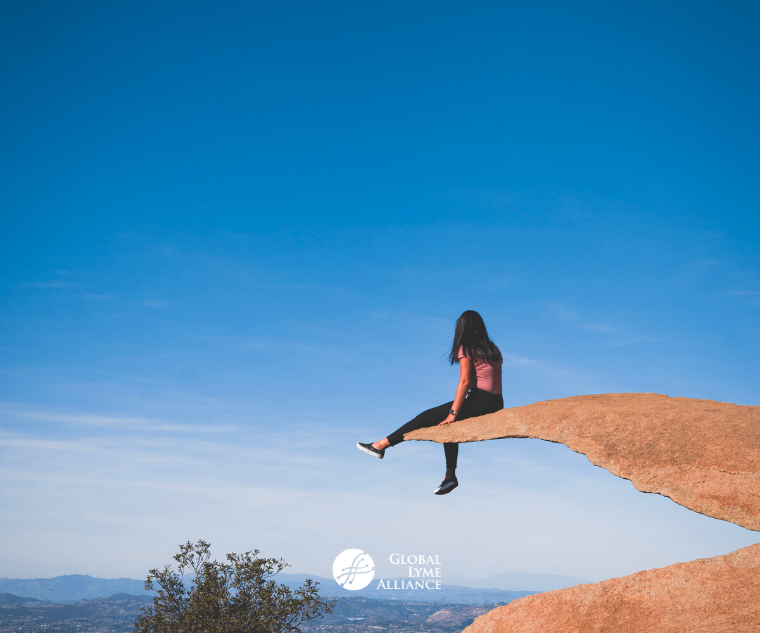
by Jennifer Crystal
When living with Lyme disease and making decisions in regards to your health, it’s important to weigh the dangers, benefits, and consequences. It’s called taking calculated risks.
When I got my PICC line (Peripherally Inserted Central Catheter) inserted for intravenous antibiotics, the nurse who did the procedure offered a number of precautions. Because the line ran to my heart, I absolutely could not get it wet; one drop of water could have fatal consequences. So, I wore a special sleeve when doing dishes, did not swim, and had someone help me wash my hair. I also had to be very careful not to catch the line on anything. After infusing my antibiotics, I wrapped the cord around my arm and covered it with a mesh sleeve. In public, I covered that sleeve with an ace bandage. To keep the PICC line clean and avoid clots, I flushed it with saline and heparin. The nurse came to clean the dressing once a week. These precautions were non-negotiable because the risks they protected me from were severe.
Other risks were not so severe, and the nurse encouraged me to weigh dangers and benefits when considering behavioral choices. For example, to avoid putting strain on the line, I wasn’t supposed to lift anything heavy. “But if someone with a baby comes to visit you,” he said, “by all means, hold the baby because that’s more important for your mental and emotional health.”
This conversation has stuck with me in my years of convalescence from Lyme disease, two other tick-borne infections—babesia and Ehrlichia—and chronic Epstein-Barr virus. In the fifteen years since I had a PICC line, I’ve achieved remission twice, relapsed once, and have gradually gotten more and more capable of living a full life. Throughout this time, I’ve had to make many risk-benefit analyses about treatment, activities, and my own behaviors.
I’ve learned that some risks are worth taking, even when I know there will be consequences. For example, at this stage of my recovery, it’s okay for me to occasionally splurge on gluten-free brownies, even if they might rile up some symptoms. On the other hand, some risks are not worth taking, because the consequences are too severe. For instance, while it’s good to get back to the activities I love, pushing my body too hard physically will just land me back in bed.
Sometimes, no matter how carefully I calculate my moves, I can’t control external factors that affect my health. Living in a big city and riding public transportation, I can’t always ward off fast-spreading viruses, no matter how well I sanitize my belongings and wash my hands. In 2013 I got norovirus, and in March 2020, I got COVID-19. I’ve learned to make the best choices possible with the information I have. For example, now, while we are still in the throes of the global pandemic, I avoid public transportation entirely.
One of the biggest risk-benefit analyses tick-borne illness patients have to make is about how much time to spend outdoors. After suffering from Lyme and/or co-infections, it’s natural to fear re-infection. But we can’t hide inside. Instead, we have to take necessary precautions, like staying out of wooded areas and on designated paths, wearing repellent, showering after spending time outdoors and checking ourselves and our animals for ticks. I am constantly calculating the risks and benefits of each outdoor activity I undertake. Is it worth it to me to play in mowed grass with my friend’s kids? Yes, if I’m wearing long pants, closed-toed shoes, and repellent. Is it worth it to me to forge through the woods with those same kids? Well, no.
As I weigh dangers, benefits, and consequences, I also think about alternative solutions. I might say to the kids, “I don’t want to play in the woods, but how about we plan a day of swimming?” If friends suggest going to a loud, crowded bar (in pre-pandemic times), I might say, “I’m going to skip that part, but would love to have dinner with you beforehand.”
Everyone has to make calculated decisions based on their own boundaries and desires. A person with diabetes has to calculate the risks of eating a slice of birthday cake. A person in a wheelchair has to assess accessibility when planning an outing. And these days, everyone has to make calculated risks. We can’t stay inside forever hiding from COVID-19, but we also have to make smart choices about when we go out, who we allow into our bubbles, and how safe it is to interact with them.
With every move we make, there’s a risk-benefit analysis, though we might not always be aware of it. We can’t always get it right, but we can learn from our experiences and make different choices based on them. We should follow scientific guidelines and we should remember that it’s all about moderation, pacing, and balance.

Opinions expressed by contributors are their own.
Jennifer Crystal is a writer and educator in Boston. Her memoir about her medical journey is forthcoming. Contact her at lymewarriorjennifercrystal@gmail.com.

Jennifer Crystal
Writer
Opinions expressed by contributors are their own. Jennifer Crystal is a writer and educator in Boston. Her work has appeared in local and national publications including Harvard Health Publishing and The Boston Globe. As a GLA columnist for over six years, her work on GLA.org has received mention in publications such as The New Yorker, weatherchannel.com, CQ Researcher, and ProHealth.com. Jennifer is a patient advocate who has dealt with chronic illness, including Lyme and other tick-borne infections. Her memoir, One Tick Stopped the Clock, was published by Legacy Book Press in 2024. Ten percent of proceeds from the book will go to Global Lyme Alliance. Contact her via email below.






-2.jpg)